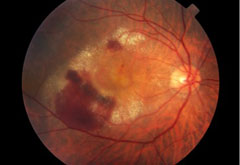 |
Common Eye Conditions
Age Related Macular Degeneration
|
The retina is the layer of nerve cells at the back of the eye which senses and transmits visual information to the brain, thus enabling us to see. The macula is the tiny spot in the centre of the retina which contains millions of light-receptors that help produce central or ‘straight-ahead’ vision. Progressive deterioration and changes in the macula usually occur with age and this is termed age-related macular degeneration (AMD). It is one of the top three causes of vision loss in those aged 60 and above. |
Causes and Types of AMD
There are two types of AMD:
Dry AMD
This forms the majority of cases of AMD and results from thinning of the macula, coupled with reduced blood flow to the retina. Waste products also accumulate under the retina, causing deposits known as drusen which then affect central vision.
The progression of dry AMD is slow and by itself, rarely causes severe visual loss or blindness.
Wet AMD
This constitutes only about 10 percent of cases of AMD and is a more serious form of the disease. It results from formation of new (but weak) blood vessels under the retina which break and cause swelling and eventually, scar tissue. The visual loss may be sudden and is usually more significant than in dry AMD.
Risk Factors for AMD
- Age
- Heredity
- Smoking
- Excessive sunlight exposure
- Diet lacking in antioxidants and high in fat
- Hypertension and heart disease
Symptoms of AMD
In dry AMD:
- gradual loss of central vision with difficulty in reading and face recognition
- gradual haziness of vision
- a ‘blind spot’ in the centre of your visual field
In wet AMD:
- distorted vision such as straight lines appearing wavy
- sudden loss of central vision
Diagnosis
The usual means of detecting and diagnosing AMD are:
- Amsler grid test
- Ophthalmoscopy
- Visual acuity tests
- Retinal photography
- Fluorescein angiography
Prevention
Early detection is important and screening is recommended for all above 50, especially those with a family history of the disease and who are in the high-risk groups mentioned above.
Smoking cessation, use of protective eyewear, control of blood pressure and dietary modifications are all helpful to slow down the progression of AMD.
Treatment
There is no proven medical treatment for dry AMD.
For wet AMD, the treatment of choice is photodynamic therapy, which combines the use of a cold laser and an intravenous dye to destroy the abnormal new blood vessels, without damaging the retina.
The other treatment available is the use of injectable drugs (eg Avastin) into the vitreous body of the eye to block the growth of new blood vessels.
In most cases, it is not possible to reverse the damage caused by AMD. However, there are ways to cope with and make use of the remaining sight eg:
- reading books with larger print
- ensure sufficient lighting for activities
- avoid driving at night or in heavy traffic
- remove obstacles in the home such as throw rugs or other tripping hazards
Common Eye Conditions
- Age Related Macular Degeneration
- Blepharitis
- Cataracts
- Central Serous Chorioretinopathy
- Contact Lens Problems
- Diabetes and the Eye
- Dry Eyes
- Floaters and Flashes
- Glaucoma
- LASIK Surgery
- Pterygium and Pingueculae
- Refractive Errors
- Retinal Detachment
- Retinal Vascular Disorders
- Uveitis and Ocular Inflammations
- Vision Problems in Children
